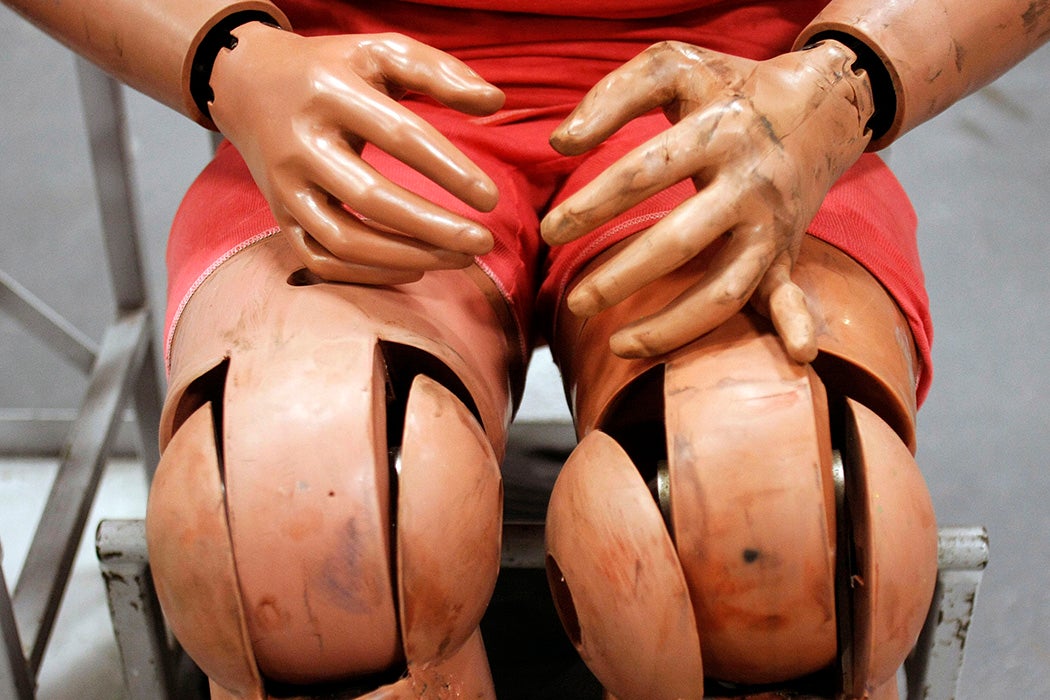In trying to design safer vehicles, car manufacturers use crash test dummies to simulate human bodies and the effects of crashes on those bodies. You may have seen videos of crash tests: a vehicle speeds into a wall or is hit from the side, its occupants a family of mannequins that rise, fall, and flail as the physics of high-impact forces send them airborne. The blank affect of dummies, originally known in the industry as “phantoms,” makes the process discomforting, but what’s worse is the realization that this is what becomes of people in a real crash.
The crash test dummies of today aren’t simple dolls. They have multiple sensors to record damage, and they’re designed to respond as humans do. Their evolution has accompanied increased safety standards in cars as well as the evolving way we use our vehicles over the past half century.
Standardized crash test dummies appeared in the 1960s. Initially, the dummies were based on those used by the US Air Force for testing pilot emergency ejections. However, the needs of aircraft engineers aren’t the same as automotive testers. The Society of Automotive Engineers (SAE) Automotive Safety Committee drafted a new design in 1963.
Their first design challenge was to determine the best (that is, median) size for dummy that would be used to test the effects of automotive impacts. Beyond that, they had to determine the ideal shape. The Air Force models
had no pelvic structure or spinal articulation. These deficiencies compromised their usefulness in the evaluation of automotive restraint systems where kinematic realism is so essential, particularly with respect to jackknifing and submarining of the body.
In addition to replicating the size and anatomy of a human more accurately, the task force also had to determine the lengths and ratios of various body parts—torso to abdomen to pelvis—as well as the range of motion of limbs and joints.
“Since human beings come in assorted sizes, with a side range of dimensional tolerances for limb lengths,” the engineers reported, “the dimensional specifications of a single anthropomorphic device as representative of a wide population of human beings becomes an abstraction.”
The dummy is all of us, yet none of us.
The engineers sought the advice of scholars from other disciplines, including anthropometrists and military doctors, to determine the dimensions of an adult male in the fiftieth percentile of the general population. They built dummies to replicate the movement of the human body that could also contain instruments inside the body cavities to record the impacts. Their research tables showed weights for all components of the dummies and the centers of gravity.
In 1974, Robert P. Hubbard and Donald G. McLeod described the further development of a crash test dummy head. Cadaver heads were weighed and measured to provide average dimensions (based on an adult male).
“For these assessments to be meaningful, dummy head responses must be representative of human head responses,” write Hubbard and McLeod. “To ensure a correspondence between human and dummy head responses, specifications and requirements based on biomechanical data must be established to define dummy head characteristics.”
The resultant dummy heads consisted of an aluminum shell with a vinyl covering that was developed to replicate the friction of human skin. The heads were then tested by dropping them onto a flat surface, an impact test designed to evaluate damage.
Weekly Newsletter
Fifty years later, human body models were becoming more sophisticated. According to Peter Andrey Smith, writing in 2016, “nearly two dozen automakers and research institutes have set out together to build a digital complement: an elaborate, 3-D computer model depicting bone, tissue and internal organs from head to toe.”
The new designs were also meant to represent human beings who are not adult males more accurately.
“Most automobile safety features were designed with the average adult male in mind,” writes Smith,
which has left children in particular not as well-protected. From an engineering standpoint, the prepubescent body has different mechanical properties, so one goal of the consortium is to make anthropomorphic details in the model account for kid-sized bodies, as well as other variations in sex and age.
These dummies help research impact not just for occupants of vehicles, but for pedestrian impact crashes as well. Even the development of driverless cars requires adjusting models. As Smith explains, dummies are an essential part of
fine-tuning the safety features of autonomous cars, which have different operating mechanisms than cars today and may sport unconventional seating configurations. For instance, in a recent paper funded by Ford Motor Company, [research scientist Jingwen] Hu found that the braking of vehicles with driver-assist technology just before a potential collision tends to alter a front-seat rider’s posture. As a result, the skull tilts forward—which could increase the risk of head injuries. The models could also soon help engineers reevaluate the operation of seat belts and air bags in this new context.
As our cars evolve, so too does our need for our physical mirrors, the dummies, to show how to keep us safe.







